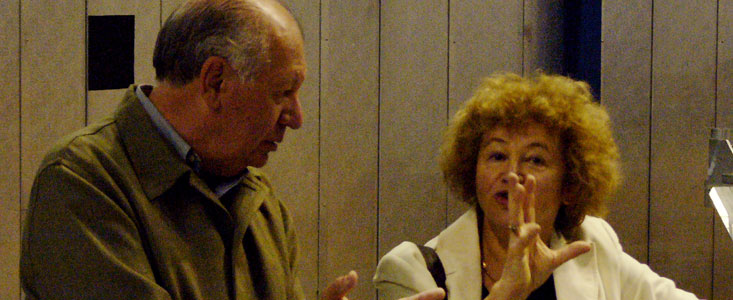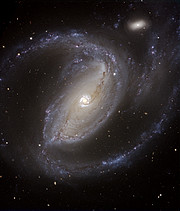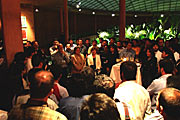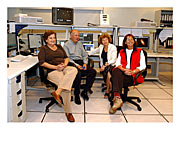Persbericht
The President and the Galaxy
Chilean Head of State Visits Paranal Observatory.
22 december 2004
On December 9-10, 2004, the ESO Paranal Observatory was honoured with an overnight visit by His Excellency the President of the Republic of Chile, Ricardo Lagos and his wife, Mrs. Luisa Duran de Lagos. The high guests were welcomed by the ESO Director General, Dr. Catherine Cesarsky, ESO's representative in Chile, Mr. Daniel Hofstadt, and Prof. Maria Teresa Ruiz, Head of the Astronomy Department at the Universidad de Chile, as well as numerous ESO staff members working at the VLT site. The visit was characterised as private, and the President spent a considerable time in pleasant company with the Paranal staff, talking with and getting explanations from everybody.
The distinguished visitors were shown the various high-tech installations at the observatory, including the Interferometric Tunnel with the VLTI delay lines and the first Auxiliary Telescope. Explanations were given by ESO astronomers and engineers and the President, a keen amateur astronomer, gained a good impression of the wide range of exciting research programmes that are carried out with the VLT. President Lagos showed a deep interest and impressed everyone present with many, highly relevant questions.
Having enjoyed the spectacular sunset over the Pacific Ocean from the Residence terrace, the President met informally with the Paranal employees who had gathered for this unique occasion. Later, President Lagos visited the VLT Control Room from where the four 8.2-m Unit Telescopes and the VLT Interferometer (VLTI) are operated. Here, the President took part in an observing sequence of the spiral galaxy NGC 1097 (see ESO Press Photo eso0438) from the console of the MELIPAL telescope.
After one more visit to the telescope platform at the top of Paranal, the President and his wife left the Observatory in the morning of December 10, 2004, flying back to Santiago.
VLT obtains a splendid photo of a unique galaxy, NGC 1097
A unique and very beautiful image was obtained with the VIMOS instrument with President Lagos at the control desk.
Located at a distance of about 45 million light-years in the southern constellation Fornax (the Furnace), NGC 1097 is a relatively bright, barred spiral galaxy of type SBb, seen face-on. At magnitude 9.5, and thus just 25 times fainter than the faintest object that can be seen with the unaided eye, it appears in small telescopes as a bright, circular disc.
The image taken on the night of December 9 to 10, 2004 with the VIsible Multi-Object Spectrograph (VIMOS), a four-channel multiobject spectrograph and imager attached to the 8.2-m VLT Melipal telescope, shows that the real structure is much more complicated. NGC 1097 is indeed a most interesting object in many respects.
As this striking image reveals, NGC 1097 presents a centre that consists of a broken ring of bright knots surrounding the galaxy's nucleus. The sizes of these knots - presumably gigantic bubbles of hydrogen atoms having lost one electron (HII regions) through the intense radiation from luminous massive stars - range from roughly 750 to 2000 light-years. The presence of these knots suggests that an energetic burst of star formation has recently occurred.
NGC 1097 is also known as an example of the so-called LINER (Low-Ionization Nuclear Emission Region Galaxies) class. Objects of this type are believed to be low-luminosity examples of Active Galactic Nuclei (AGN), whose emission is thought to arise from matter (gas and stars) falling into oblivion in a central black hole.
There is indeed much evidence that a supermassive black hole is located at the very centre of NGC 1097, with a mass of several tens of million times the mass of the Sun. This is at least ten times more massive than the central black hole in our own Milky Way.
However, NGC 1097 possesses a comparatively faint nucleus only, and the black hole in its centre must be on a very strict "diet": only a small amount of gas and stars is apparently being swallowed by the black hole at any given moment.
A turbulent past
As can be clearly seen, NGC 1097 also has a small galaxy companion; it is designated NGC 1097A and is located about 42,000 light-years away from the centre of NGC 1097. This peculiar elliptical galaxy is 25 times fainter than its big brother and has a "box-like" shape, not unlike NGC 6771, the smallest of the three galaxies that make up the famous Devil's Mask.
There is evidence that NGC 1097 and NGC 1097A have been interacting in the recent past.
Another piece of evidence for this galaxy's tumultuous past is the presence of four jets - not visible on this image - discovered in the 1970's on photographic plates. These jets are now believed to be the captured remains of a disrupted dwarf galaxy that passed through the inner part of the disc of NGC 1097.
Moreover, another interesting feature of this active galaxy is the fact that no less than two supernovae were detected inside it within a time span of only four years. SN 1999eu was discovered by Japanese amateur Masakatsu Aoki (Toyama, Japan) on November 5, 1999. This 17th-magnitude supernova was a peculiar Type II supernova, the end result of the core collapse of a very massive star. And in the night of January 5 to 6, 2003, Reverend Robert Evans (Australia) discovered another Type II supernova of 15th magnitude.
Also visible in this very nice image which was taken during very good sky conditions - the seeing was well below 1 arcsec - are a multitude of background galaxies of different colours and shapes. Given the fact that the total exposure time for this three-colour image was just 11 min, it is a remarkable feat, demonstrating once again the very high efficiency of the VLT.
Over dit bericht
| Persberichten nr.: | eso0438 |
| Legacy ID: | PR 28/04 |
| Naam: | ESO Director General, Meeting, NGC 1097, President |
| Type: | Unspecified : People |
| Facility: | Very Large Telescope |
Our use of Cookies
We use cookies that are essential for accessing our websites and using our services. We also use cookies to analyse, measure and improve our websites’ performance, to enable content sharing via social media and to display media content hosted on third-party platforms.
ESO Cookies Policy
The European Organisation for Astronomical Research in the Southern Hemisphere (ESO) is the pre-eminent intergovernmental science and technology organisation in astronomy. It carries out an ambitious programme focused on the design, construction and operation of powerful ground-based observing facilities for astronomy.
This Cookies Policy is intended to provide clarity by outlining the cookies used on the ESO public websites, their functions, the options you have for controlling them, and the ways you can contact us for additional details.
What are cookies?
Cookies are small pieces of data stored on your device by websites you visit. They serve various purposes, such as remembering login credentials and preferences and enhance your browsing experience.
Categories of cookies we use
Essential cookies (always active): These cookies are strictly necessary for the proper functioning of our website. Without these cookies, the website cannot operate correctly, and certain services, such as logging in or accessing secure areas, may not be available; because they are essential for the website’s operation, they cannot be disabled.
Functional Cookies: These cookies enhance your browsing experience by enabling additional features and personalization, such as remembering your preferences and settings. While not strictly necessary for the website to function, they improve usability and convenience; these cookies are only placed if you provide your consent.
Analytics cookies: These cookies collect information about how visitors interact with our website, such as which pages are visited most often and how users navigate the site. This data helps us improve website performance, optimize content, and enhance the user experience; these cookies are only placed if you provide your consent. We use the following analytics cookies.
Matomo Cookies:
This website uses Matomo (formerly Piwik), an open source software which enables the statistical analysis of website visits. Matomo uses cookies (text files) which are saved on your computer and which allow us to analyze how you use our website. The website user information generated by the cookies will only be saved on the servers of our IT Department. We use this information to analyze www.eso.org visits and to prepare reports on website activities. These data will not be disclosed to third parties.
On behalf of ESO, Matomo will use this information for the purpose of evaluating your use of the website, compiling reports on website activity and providing other services relating to website activity and internet usage.
Matomo cookies settings:
Additional Third-party cookies on ESO websites: some of our pages display content from external providers, e.g. YouTube.
Such third-party services are outside of ESO control and may, at any time, change their terms of service, use of cookies, etc.
YouTube: Some videos on the ESO website are embedded from ESO’s official YouTube channel. We have enabled YouTube’s privacy-enhanced mode, meaning that no cookies are set unless the user actively clicks on the video to play it. Additionally, in this mode, YouTube does not store any personally identifiable cookie data for embedded video playbacks. For more details, please refer to YouTube’s embedding videos information page.
Cookies can also be classified based on the following elements.
Regarding the domain, there are:
- First-party cookies, set by the website you are currently visiting. They are stored by the same domain that you are browsing and are used to enhance your experience on that site;
- Third-party cookies, set by a domain other than the one you are currently visiting.
As for their duration, cookies can be:
- Browser-session cookies, which are deleted when the user closes the browser;
- Stored cookies, which stay on the user's device for a predetermined period of time.
How to manage cookies
Cookie settings: You can modify your cookie choices for the ESO webpages at any time by clicking on the link Cookie settings at the bottom of any page.
In your browser: If you wish to delete cookies or instruct your browser to delete or block cookies by default, please visit the help pages of your browser:
Please be aware that if you delete or decline cookies, certain functionalities of our website may be not be available and your browsing experience may be affected.
You can set most browsers to prevent any cookies being placed on your device, but you may then have to manually adjust some preferences every time you visit a site/page. And some services and functionalities may not work properly at all (e.g. profile logging-in, shop check out).
Updates to the ESO Cookies Policy
The ESO Cookies Policy may be subject to future updates, which will be made available on this page.
Additional information
For any queries related to cookies, please contact: pdprATesoDOTorg.
As ESO public webpages are managed by our Department of Communication, your questions will be dealt with the support of the said Department.







